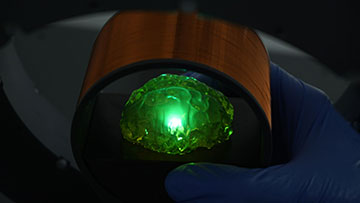
Wirelessly powered OLED light bulb illuminating a transparent brain phantom. [Image: Julian Butscher]
Biomedical researchers and clinicians would love to use tiny photonic devices to image and treat conditions inside a patient’s body. Connecting miniature light sources to in vivo batteries via electrodes, however, can be a challenge within living tissue, and classical designs for wireless power transfer would require antennas many meters long.
Now, researchers based in Europe have designed tiny organic light-emitting diodes (OLEDs) mounted on magnetoelectric transducers that harvest power from a sub-megahertz electromagnetic field (Sci. Adv., doi:10.1126/sciadv.adm7613). These small, integrated light sources could lead to new sensing and disease-treatment applications under the skin and within organs.
The versatility of OLEDs
Four decades of research have brought OLEDs into the mainstream of applications, such as smartphone displays. Many scientists believe that these organic devices present several advantages over their inorganic cousins for photodynamic therapy and biomedical imaging. For example, OLEDs can be fabricated in virtually any shape and emission color.
In this proof-of-concept study, a team from the University of Cologne, Germany, and the University of St. Andrews, UK, created a magnetoelectric transducer consisting of an amorphous metal ribbon bonded to a piezoelectric ceramic sheet. In the presence of a magnetic field, the ribbon deforms and induces a voltage across the ceramic material. The transducer also serves as a substrate for a pair of OLEDs in an antiparallel arrangement, so that the current can flow in both directions.
According to lead author Julian Butscher, University of St. Andrews, the group used an iridium-based red-emitting (600 to 614 nm peak) semiconductor material that has become a standard for highly efficient phosphorescent OLEDs. “Red emission is beneficial for OLEDs, as high efficiencies can be obtained,” he explains, “But also for biomedical applications, as red light penetrates deeper into tissue than, for instance, blue light.”.
The technique will allow future researchers to shrink the size of the devices further without changing the fabrication method.
Unprecedented miniaturization
Although the phosphorescent material is conventional, the fabrication of the OLED on the magnetoelectric substrate “allows for an unprecedented miniaturization of the device,” Butscher says. The technique will allow future researchers to shrink the size of the devices further without changing the fabrication method. Malte Gather, University of Cologne, says the fabrication expertise and infrastructure at Cologne’s Humboldt Centre for Nano- and Biophotonics helped create the magnetoelectric power harvesters that replaced the usual glass OLED substrates.
“We are already in the process of further miniaturizing our devices and started collaborations with neuroscientists to explore their application in a biologically relevant context,” Butscher says. “There are still many challenges to solve, but we are optimistic that the first trials on human patients could be conducted within the next decade.”
